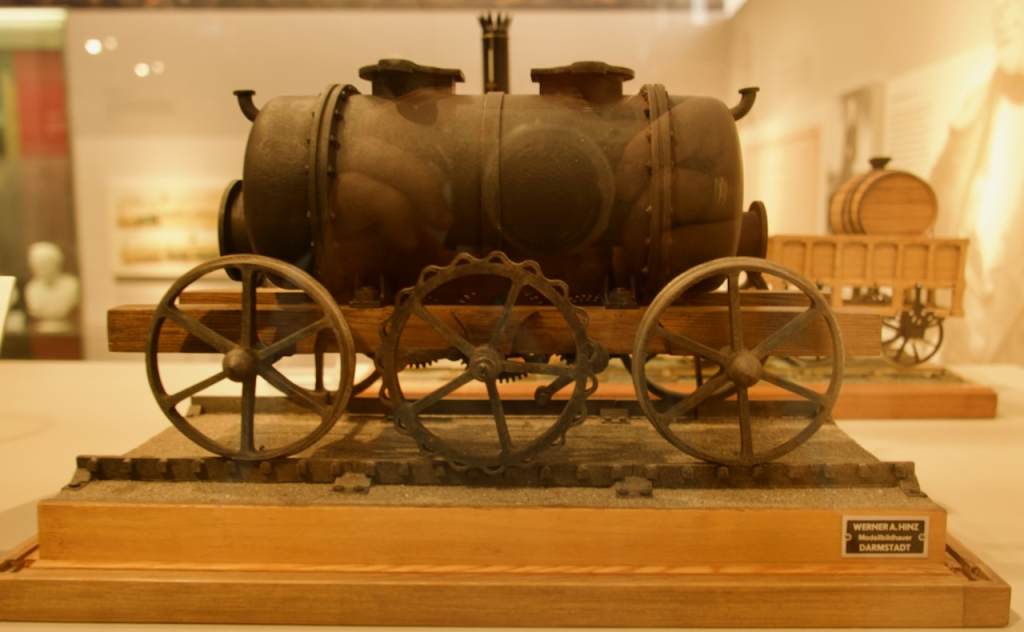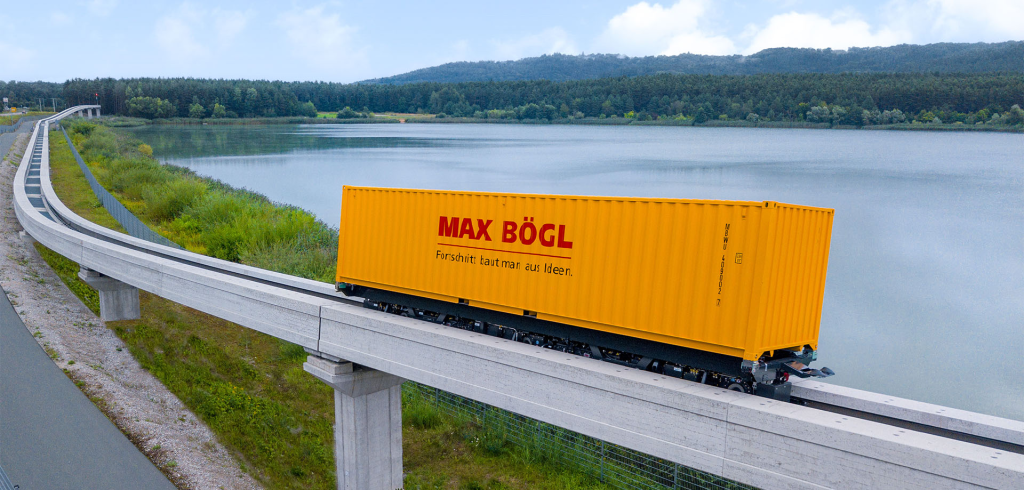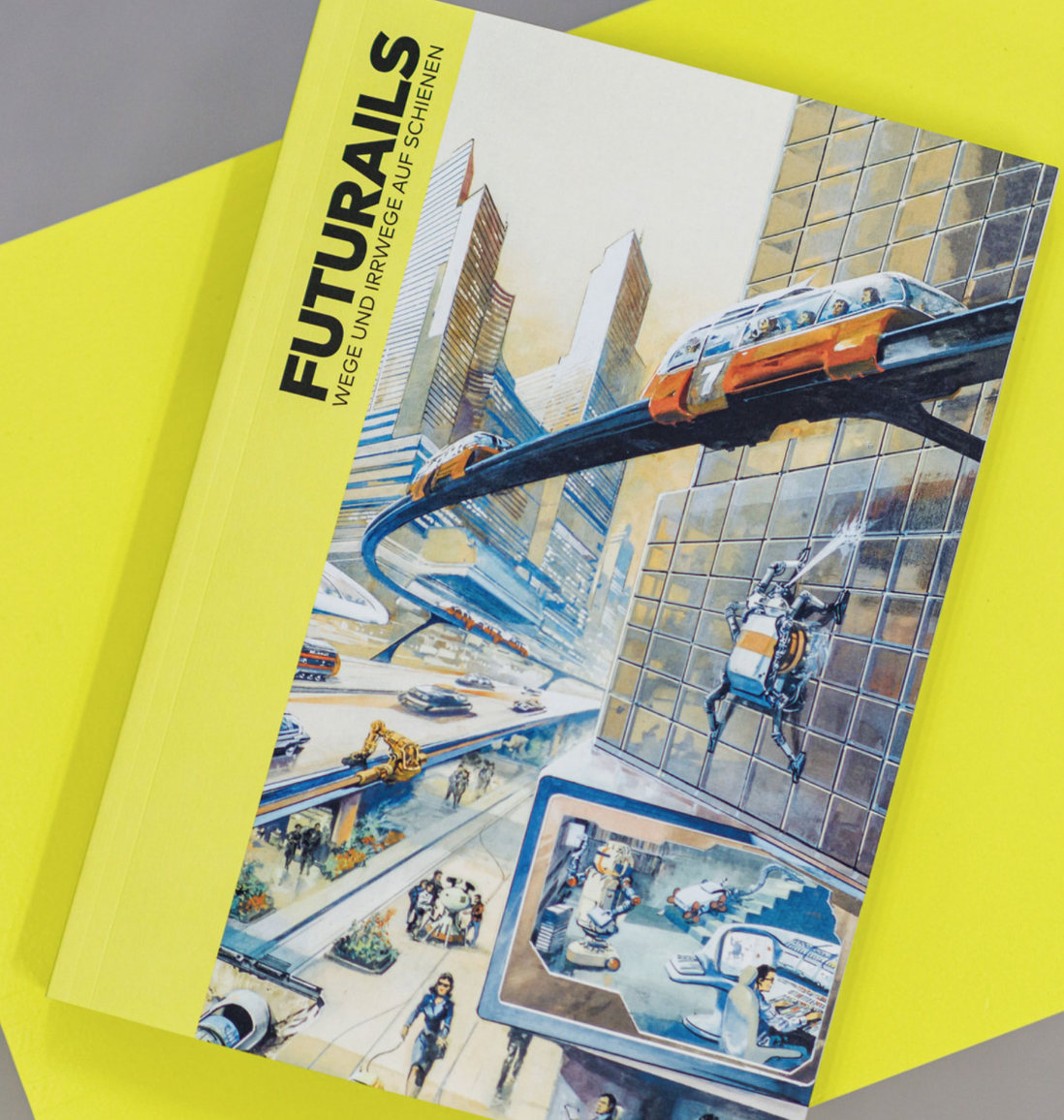The German Railway Museum in Nuremberg is currently showing the special exhibition “Futurails”. It shows how many alternatives to the railway system have been discussed over the course of 200 years. With an excellent selection of exhibits, it gives the visitor an idea of all the ideas that clever people have come up with, and tries to explain why the railroad still looks pretty much the same 200 years later.
Introduction
The German Railway Museum (“the DB Museum”) is located in the city of Nuremberg, Bavaria. This is a fitting location, as Nuremberg is the place where the first railroad in Germany was built in 1835. The museum shows the history of the German railroad from its humble beginnings through the maximum expansion of the railroad network to modern times. It also has many original locomotives and wagons from nearly 200 years of history on display.
It also has a large space for special exhibitions. The current special exhibition is called Futurails. In this article I want to give you an overview of what you can learn in this unique look at railroad history.
The Exhibition
The subtitle of the exhibition is “Wege und Irrwege auf Schienen”, which could be translated as “Ways and Wrong Ways on Rails”. And there have been plenty of wrong tracks in the history of the railway system and the attempts to replace it with new technologies.
The railroad system as we know it today is based on the simple concept of two rails (first iron, now steel). On top of these two rails we have wheels, again made of steel, and cars and locomotives sit on these wheels. In this way, the cars can be pulled with much less frictional resistance compared to wheels on roads. This fact has made railways one of the most energy efficient transportation systems to date.
But is this the best approach to a rail system? Could there be a better one? This is a question that inventors and businessmen have been trying to answer for the past 200 years.
The Beginnings
The show starts at the very beginning, in the early years of the 19th century. The steam locomotive had already been invented by Richard Trevithick and was being used in coal mines. However, it was not clear at the time that the concept would work. Some people, like the German inventor Joseph von Baader, thought steam engines were too inefficient and preferred horses to pull carriages. Also, the first rails were made of cast iron, which could not support too heavy loads, which in turn limited the weight of the locomotives. But locomotives had to have a certain minimum weight because the friction between wheels and rails was so low. And when friction is low, you need enough weight to generate the traction to pull heavy trains. Because of this, many contemporaries believed that it would not be possible to use friction alone to pull trains. Several concepts were tried to overcome this problem. At the Nuremberg show, there is a model of a locomotive based on the Blenkinsop system. Here, a cogwheel on the locomotive fits into a rack mounted parallel to the tracks. This overcomes the problem of low friction between wheels and rails.

This worked well enough, but a few years later, new rails made of steel could carry heavier locomotives, and it was shown that pure friction was enough to pull even heavy trains. And this is how railroads work to this day (except for railroads in mountainous regions, which still use a rack-and-pinion approach).
This shows a common theme in the history of railroads: People see flaws in the railroad system and try to fix them with a new approach. But shortly thereafter there is an improvement in railroad technology that makes any alternative approach obsolete.
Rise of the Monorails
After the initial phase of finding the best solution, the railroad system settled on the one we still use today. In this form, it conquered the world and after a few decades, steam trains puffed over the rails, connecting cities around the globe.
At the end of the 19th century, a new idea was born: The monorail.
In a frenzy of development, many different types of monorails were created. Most of them did not make it from the prototype stage to real implementation. And even those that did are limited to small-scale implementations, far from the networks envisioned by their proponents. One of the better-known monorials is the Wuppertal suspension railway, which I wrote about a few months ago. Or maybe you know the “Alweg Monorail”. If you have been to the Disneyland amusement park, you might have ridden one of these. It is also featured in the famous Simpsons episode about the Springfield Monorail.

This is another feature of the exhibit: It shows not only practical attempts at new rail systems, but also the reception and ideas from popular culture and even science fiction. And monorails are a big part of 20th century science fiction, most of the futuristic transportation concepts in science fiction are monorails.
As we all know, monorails have not made the leap to large-scale implementation. One reason given in the exhibit is that railroads have improved with electrification and higher speeds, eliminating the need to invest in new infrastructure. It also says that monorails would be very expensive because they require elevated stations, which are more expensive to build than ground-level stations.
I also see other problems that prevent monorails from forming a nationwide network, which I have identified in my article on the Wuppertal Suspension Railway.
Atomic Railroads
A very interesting – and a bit frightening – episode of the railroad system were the atomic locomotives. These were supposed to be powered by a nuclear reactor, like a nuclear submarine. This idea was developed in both the East and the West during the Cold War. Fortunately, it was never adopted…
Maglev
The latest idea to improve conventional rail is the concept of trains that float on a magnetic field. These maglev trains have been in development for many decades. Apart from a line based on the Transrapid system connecting Shanghai airport to the city, there is only one major line under construction. It will connect Tokyo and Nagoya in Japan with a travel speed of 505 km/h.
While the speed will be very high, the effort to build this line in the mountainous geography of Japan is enormous. A total of 256 km of tunnels will have to be dug. The result will be a high travel speed, but the line will have limited capacity because the trains will be smaller than conventional trains and will need to travel at a greater safety distance due to the high speed.
The huge construction effort required is one reason why high-speed maglev trains have not yet taken off. The other reason is that conventional rail now also offers very high speeds, e.g. bullet trains in China routinely reach speeds of 350 km/h. The additional speed that can be achieved with maglev does not seem to justify the effort, since trains cannot run at top speed all the time.
For these reasons, maglev development seems to be going in two different directions.
One direction is even higher speeds. Think of the idea of the Hyperloop (which has many predecessors, as I have written here). It is supposed to reach 1200 km/h or more. This idea is also presented in the exhibition, together with some pictures of the TUM Hyperloop team. A concept to go even faster and justify the effort to reach high speeds with a continent-wide network is the Hypersonic Railway. It is not on display in Nuremberg, but I reviewed the book that promotes it in this article.
Another direction maglev could go is lower speeds. This is the idea behind the “Transportsystem Max Bögl” (link) or TSB for short. The German company Max Bögl is developing a new transportation system based on the Transrapid technology. The goal is not to reach high speeds, but to have a lower speed and more reliability. The TSB system’s maglev train can climb steeper grades and negotiate tighter radii than conventional trains. This makes it possible to build lines with less effort compared to conventional lines. Another advantage is that the train makes less noise and requires less maintenance because there is no friction between the train and the track.
TSB is targeting both local transport of people and goods, for example within port facilities.

This concept seems very promising to me. But so far no real live applications have been built or seem to be under construction. Let’s see how it develops. [Update 01.04.2024: In the meantime, I could visit the TSB test facilities in Sengenthal. Read more about it in this article.]
Conclusion
The Futurails exhibition offers a unique perspective on the history of the rail system. By looking at how many alternative ideas that sounded brilliant at the time failed to replace the existing system, we can get a better estimate of the chances of new ideas being proposed today.
If you are interested in the past and future of the railroad system or transportation in general, I highly recommend visiting the exhibition. You have the chance to do so until December 3, 2023.
The exhibition is in German and English, so it is also accessible to international visitors.
I can also recommend the accompanying book. It is very well illustrated and repeats and further explains the main points of the exhibition. Unfortunately it is only available in German. If you can’t come to the museum, you can order the book online (link to the shop of the DB Museum).
In any case, this is a unique opportunity. Don’t miss it!

3 replies on “Futurails – 200 Years of Trying to Replace the Railroad”
[…] In his letters to shareholders in 2009 and 2010, Warren Buffett gave several reasons for buying a railroad. One reason was that they were looking for a way to invest the large amount of cash that Berkshire Hathaway had. And they invested it in rail because they saw a bright future for this already quite ancient mode of transport: […]
[…] that they have interested partners.Right now, it looks like the Ottobahn is going to be another futuristic concept that fails to replace the existing transportation system. But I hope I am wrong, because the […]
[…] Transport System Bögl in the exhibition Futurails in the Nuremberg Transportation Museum (see my article).This exhibition showed many transportation systems that tried to replace conventional railways in […]